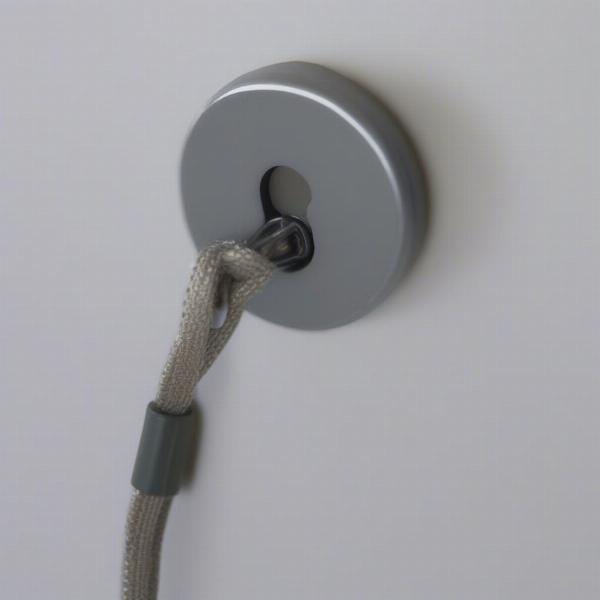Flexi dog leads, also known as retractable dog leashes, offer dog owners a convenient way to give their furry friends more freedom while maintaining some control. But are they the right choice for every dog and every situation? This guide will delve into the pros and cons of flexi leads, addressing safety concerns, training tips, and best practices for using them responsibly.
Understanding Flexi Dog Leads
Flexi leads allow dogs to explore a wider area than traditional leashes, giving them a sense of independence. They work by using a retractable cord that extends and retracts automatically, adjusting to the dog’s movements. This can be particularly appealing for active dogs who enjoy roaming and sniffing. However, this freedom comes with responsibilities.  Flexi Lead Mechanism
Flexi Lead Mechanism
Advantages of Flexi Leads
- Increased Freedom: Flexi leads give dogs more room to explore and sniff, which can be mentally and physically stimulating.
- Variable Length: The retractable cord allows you to adjust the length of the leash according to the environment and your dog’s behavior.
- Convenience: They are generally lightweight and easy to handle, making walks more comfortable for the owner.
- Suitable for Various Environments: Flexi leads can be useful in parks, open fields, and other areas where a longer leash is beneficial.
Potential Downsides and Safety Concerns
While flexi leads offer advantages, it’s important to be aware of the potential drawbacks:
- Risk of Injuries: The thin cord can cause burns, cuts, or entanglement for both dogs and owners if not handled carefully. Sudden jerks can also strain the dog’s neck and back.
- Less Control: The extended length can make it challenging to control your dog quickly in emergencies, especially with larger or reactive dogs.
- Training Challenges: Flexi leads can inadvertently encourage pulling and other undesirable behaviors if not used correctly.
- Potential for Damage: The cord can easily get tangled around objects or other dogs, leading to frustration and potential damage.
Choosing the Right Flexi Lead
- Size and Weight: Select a lead appropriate for your dog’s size and weight. Using a lead designed for a smaller dog with a larger breed can be dangerous.
- Cord Type: Consider a tape leash over a cord, as tape leashes are generally more durable and less likely to cause injuries.
- Brake System: Ensure the brake system is reliable and easy to engage quickly in any situation.
Training Tips for Using a Flexi Lead
- Basic Obedience: Ensure your dog has a solid foundation in basic obedience commands like “come,” “stay,” and “heel” before using a flexi lead.
- Gradual Introduction: Introduce the flexi lead gradually, starting with short, supervised sessions in a safe, enclosed area.
- Consistent Control: Maintain a consistent level of control, avoiding sudden jerks or allowing the cord to become fully extended in crowded or unpredictable environments.
- Positive Reinforcement: Use positive reinforcement techniques to reward your dog for walking politely on the lead.
Conclusion
Flexi dog leads can be a useful tool when used responsibly and with proper training. By understanding the potential risks and following these guidelines, you can ensure the safety and well-being of both your dog and yourself while enjoying the added freedom a flexi lead provides. Remember to always prioritize safety and responsible dog ownership when using a flexi lead.
FAQ
- Are flexi leads good for puppies? Generally, it’s recommended to avoid flexi leads for puppies until they have mastered basic leash training.
- Can I use a flexi lead for jogging with my dog? While some flexi leads are marketed for jogging, it’s crucial to prioritize safety and control, which can be compromised with a retractable lead. A fixed-length leash is generally safer for jogging.
- How do I prevent my dog from pulling on a flexi lead? Consistent training with positive reinforcement is key. Reward your dog for walking calmly by your side and gently correct pulling behavior.
- What should I do if the cord breaks on my flexi lead? Immediately secure your dog and replace the lead. Inspect the lead regularly for signs of wear and tear.
- Are there any alternatives to flexi leads? Yes, fixed-length leashes, long lines, and harnesses are all alternatives depending on your needs and your dog’s temperament.
- How do I clean my flexi lead? Follow the manufacturer’s instructions for cleaning. Generally, wiping the casing with a damp cloth and occasionally cleaning the cord with mild soap and water is sufficient.
- Where can I buy a high-quality flexi lead? Reputable pet stores and online retailers offer a variety of flexi leads. Be sure to choose a reputable brand known for quality and safety.
Introducing ILM Dog
ILM Dog is your trusted resource for expert advice on all aspects of dog care, from breed selection and puppy care to senior dog health and training tips. We offer practical, reliable information to help you provide the best possible care for your furry friend. Whether you are a new dog owner or an experienced one, we are here to support you on your journey. Contact us for expert advice and personalized support: Email: [email protected], Phone: +44 20-3965-8624.